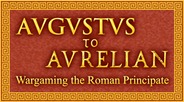Several people have asked me, here on this blog and in other places, to tell them a little more about AVGVSTVS to AVRELIAN. It's very difficult to know what to write, without reproducing chunks of the rules as some sort of 'part-work'. Making a start isn't very difficult - below I present a slightly edited version of the introduction to the rules, as it stands now. You need to bear in mind that things may still change before publication, but that the basic premises underpinning the game will remain the same.
The aim of this game of ancient warfare is to provide a fun wargaming experience, which is also a reasonably good, if somewhat abstract, simulation. After reading a lot of ancient history, the author believes that most ancient generals had only limited control over their armies once deployment was complete and the advance to contact had begun. Almost the only way for them to influence matters was to be in the right place, hopefully at the right time, or to ‘get stuck in' at a critical point in the fighting.
The above being the case, the game plays rather differently to most ancient wargames. The emphasis is not on the ‘micro-management' of individual units. Rather, it is hoped that the player will take on the role of the ancient general, accept that he has limited control, and enjoy trying to make the most of what influence he has. The player's role most of the time, rather like that of the ancient general, is one of reacting to events rather than controlling them. This may be a source of frustration if you're used to having minute control over every aspect of the battle.
Ancient armies, partly by virtue of poor communications, seem to have had a lot of ‘inertia' – once they were doing one thing, it was difficult to get them to change to do something different. There was also a lot of ‘friction', or 'Fog of War' in ancient battles. We hope that the sequence of play reflects this. There's plenty of suspense – will the card you need come up this round or not – and what will you do if it doesn't? This reliance on cards to govern the round sequence is intended to model the ‘unusual' things that occur on battlefields, and which serve to ensure that, as Von Moltke the Elder said “No plan of operations extends with certainty beyond the first encounter with the enemy's main strength”. The skill in this game lies in how you, the general, cope with the things circumstances throw at you.
Currently, the game is aimed purely at battles around the time of the Roman Principate – let's say from 27BC – AD275. If it seems to be popular, demand exists, and we're still interested, we may extend it to cover other periods. Period flavour is important though, and we believe that most sets of ancients rules try to cover too long a period, and thereby end up losing that vital aspect, so that all games, between all opponents feel, essentially, the same.
And now a tiny clipping from the 'Designer's Notes', to explain why I picked the Roman Principate for this set of rules.
Why the Roman Principate? Quite simply because it's the period of history that fascinates me most, and about which I know most (where 'most' isn't much!). The aim was to produce fairly tightly-focussed rules, in which the ‘period flavour' would be maximised, whilst paying the price of them not necessarily being easy to adapt to other periods. Even if this project ends up covering a wider period, it was easiest to start with what I know best, and write a set of rules which were solidly based in my favourite period, one in which I thought I knew enough to know how to make things work. If I could make them work for that period, the argument went, I'd end up with something robust which, if I (or others) felt like it, could be amended to suit other periods. But you've got to start somewhere. And my feeling has long been that most sets of ancients rules try to cover too much ground, and end up being rather bland as a result, so I picked a period of about 300 years which I knew fairly well, and which seemed to 'hang together', militarily. I hope these rules are satisfying, and that the flavour is ‘Roman enough' for you!
In my next entry I'll probably go into a little more detail about the whys and wherefores of the mechanics, and why I've designed things the way I have.
